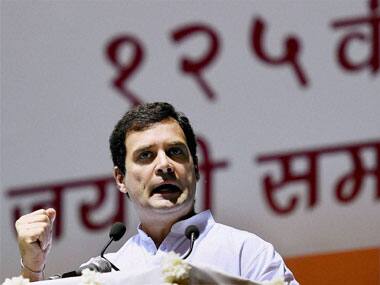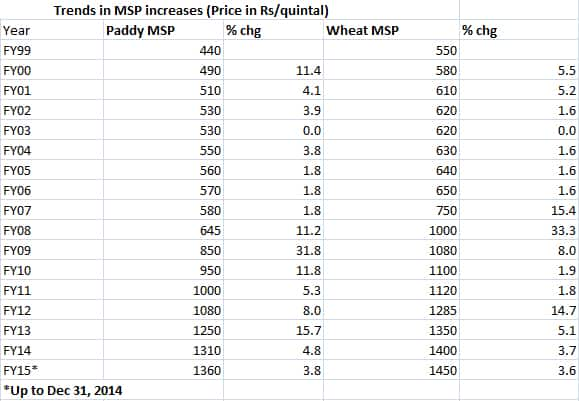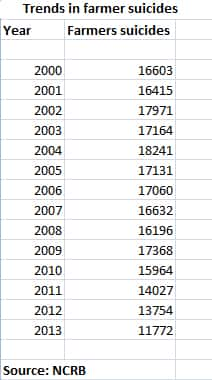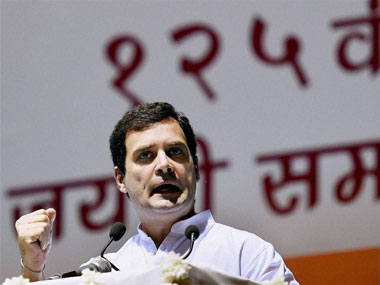Rahul Gandhi, who boarded a train to Punjab to see how its farmers are faring, has clearly decided that the issue of farm distress will be his route to political relevance in the Modi era. After his “suit-boot ki Sarkar” jibe, which pitted poor farmers against rich industrialists, today he targeted Modi’s ‘Make in India’ campaign by saying this programme did not include “labourers and farmers." [caption id=“attachment_2197442” align=“alignleft” width=“380”]  Congress vice-president Rahul Gandhi. PTI[/caption] While political jousting is fine, at some point Rahul-baba’s claims must be scrutinised in the bright light of facts and figures. Using anecdotal evidence on farmer suicides may help him position himself as a rural messiah to the gullible, but the actual numbers do not suggest that his suggested remedies - higher increases in minimum support prices (MSPs), debt waivers, and more bank credit to the farm sector - will fix the problem. Gandhi also claimed that the UPA regime had made sharp increases in MSPs as against the anaemic ones given by the NDA after Modi came to power in May last year. Given that the Modi regime still has four years to run, the second part of the allegation - that the NDA gave poor increases - need not be examined right now. It could change. A close look at the numbers relating to MSP increases and farmer suicides shows no particular linkage between the two. Nor do the figures bear out Rahul Gandhi’s contention that the UPA was always more benevolent on MSP hikes. Pre-election years were the major exceptions to the rule of low MSP increases under UPA. [caption id=“attachment_2218882” align=“aligncenter” width=“579”]  Table 2[/caption] In the first four years of UPA-1 (see table 2), MSP hikes remained low – ranging from 3.8 percent in 2004 to a pathetic 1.8 percent in the next three years. Since these were years of high growth and rising tax revenues, the UPA cannot even claim that it did not have the resources to subsidise farmers with high MSP increases. Farmer suicides during these four years averaged a high 17,266 annually (see table 1). [caption id=“attachment_2218886” align=“alignleft” width=“212”]  Table 1[/caption] As elections neared, UPA boosted MSPs dramatically, setting the stage for high food inflation and a growth slowdown due to the unsustainable fiscal deficits of UPA-2. MSPs went up by an average of 18.3 percent between 2007-08 and 2009-10, but farmer suicides remained high at an average of 16,486 annually during those three high MSP years, which included one year – 2008 – in which Rs 72,000 crore of farm debt was also waived in a pre-election sop. This shows that there may be no one-to-one link between loan waivers and foodgrain MSPs and trends in farmer suicides. The big change in the suicide trend (downwards) began after 2009 – a year after the loan waivers were announced. The suicide rate began to fall year after year, hitting a low of 11,772 in calendar 2013. It is not clear if this secular trend has reversed in 2014 or not. Till that is clear, we can’t assume there has been any sustainable directional shift in the suicide rate among farmers. However, there is another – stronger – correlation that may explain the fall in farmer suicides after 2010: strong rural wage growth, no doubt due to a bustling economy, strengthened by the NREGA scheme that guaranteed 100 days of employment for one member of any household every year. Rural wage growth went into double digits from 2008 and remained so till early 2014. But towards the end of 2014, wage growth tanked to 3.8 percent, well below the inflation rate. It is more than likely that rural wage growth has strong linkages to general economic growth, which started tapering off after 2011-12. This drop in growth rate was due to over-spending through much of UPA-2, which necessitated a sharp cut in plan spending during the Pranab Mukherjee and P Chidambaram years. As the economy slowed, the rural sector and wage growth too slowed. One can also surmise that the fall in farm suicide rates seen from 2010 to 2013 was the result of this strong wage trend and faster economic growth - to which higher MSPs would have added fuel. Once the election boost to MSPs wore off, the farm stimulus was no longer sustainable, and wage growth tapered off due the the general economic slowdown brought on by the need to contain the fiscal deficit. It remains to be seen if suicide rates have actually risen due to the wage growth slowdown in 2014 or not, though the drop in farm output due to a weak monsoon last year and the unseasonal rains and hailstorms this year may have made life difficult for farmers. On the other hand, the drop in the rate of MSP increases would have been compensated partially by a sharp fall in food inflation – which should have made up for some of the rural wage growth slowdown. Moreover, MSPs are given only for rice, wheat and a few pulses in food surplus states. This means the moderation in MSP hikes would have impacted farmers only in those states where the government procures most of its stocks. These are the five states of Punjab, Haryana, Uttar Pradesh, Madhya Pradesh and Chhattisgarh. But farmer suicides are a rarity in these states, and are more prevalent in Maharashtra and Telangana. According to data given out by the government last month in parliament, out of the 1,109 cases of agrarian distress-related farmer suicides in 2014, as many as 986 were from Maharashtra, 84 from Telangana and 29 from Jharkhand. (These figures vary from the higher suicide figures put out by the National Crime Records Bureau, from where the Table 2 figures are taken, because a farmer suicide can have other reasons than merely huge debt burden or crop failures. In fact, most farmer suicides do not relate to farm distress). What this shows is that farmer suicides have little to do MSPs themselves and that they may afflict some states more than the rest.If rural/farmer suicides have indeed risen now, it could be more related to the wage slowdown resulting from the economic decline under UPA-2. A study by Jonathan Kennedy and Lawrence King suggests that suicides correlate more to farmers producing cash crops (cotton, cane), and especially those with marginal land holdings and high debts. This would suggest that loan waivers would help, but the solution may be to provide price support to cash crops and reducing the number of farmers holding marginal acreage. Anecdotally, we know that Vidarbha - the suicide capital of India - depends on cotton farming, and many suicides relate to this crop. A reduction in suicide rate may thus be achieved by getting farmers to sell land for a good price, and giving them support and skills to pursue new careers, so that the remaining farmers can invest in larger pieces of land and improve productivity and profits. A small amount of price support to cash crops in bad years may also help. The solutions to the problem of suicide are thus localised and specific. The more generalised approach should be to reduce the number of farmers with uneconomic land holdings, investing in re-skilling them, investing in infrastructure and factories to provide them jobs, and giving farmers annuities based on the land they are willing to sell, or are forced to sell when their land is acquired for public purposes. Writing off debts can help marginally, but this comes at the cost of making our banks sick instead, as it worsens the repayment culture in rural areas. Moreover, the real issue is indebtedness to private moneylenders, and no loan waiver can help marginal farmers with private debts. So even loan waivers have limited utility. Rahul Gandhi’s solutions are largely hokum. But the lesson for Narendra Modi is to take the high road and present his land acquisition law differently. It has to be a political pitch showing how farmers can earn more by parting with their land for a profitable price than by holding on to it to earn low incomes from sub-optimal farm productivity. (Data support: Kishor Kadam)
Rahul Gandhi can milk the farm distress politically for what it is worth, but his solutions for the problem of farmer suicides are simply non-solutions. Higher MSPs and debt waivers are not the solutions to suicides, figures show
Advertisement
End of Article
Written by R Jagannathan
R Jagannathan is the Editor-in-Chief of Firstpost. see more


)

)
)
)
)
)
)
)
)



